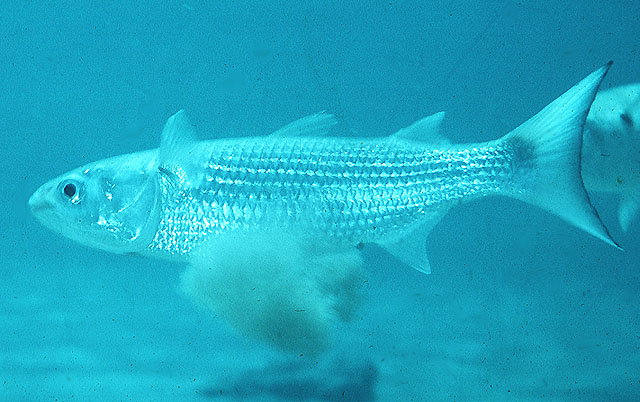| Mugilidae (Mullets) |
| 90 cm TL (male/unsexed); max.weight: 680.0 g |
|
reef-associated; depth range 0 - 300 m, catadromous |
| Western Atlantic: Nova Scotia, but uncommon north of Cape Cod (Harrison, pers. Comm.) to Argentina (Ref. 74796). Eastern Atlantic: Senegal River outlet southwards to the Congo River outlet (Democratic Republic of the Congo)(Ref. 57400). Eastern Pacific: Gulf of California to Chile (Ref. 9321). |
|
Dorsal spines (total): 4-5; Dorsal soft rays (total): 8-9; Anal spines: 3-3; Anal soft rays: 9-10. Diagnosis: body stout, rounded in cross-section; head broad; inter-orbital space flat; a well developed adipose eyelid covering most of pupil; upper lip simple, thicker and deeper than in most Mugil species, armed with 2-3 rows, teeth in outer row curved, monocuspid and widely spaced; a vertical line from hind end of upper jaw positioned midway between posterior nostril and anterior eye margin; maxillary pad not visible below corner of mouth when closed; origin of 1st dorsal fin equidistant from snout tip and caudal-fin base; pectoral axillary process well developed (30-37% of pectoral-fin length); dorsal and anal fins entirely (and more or less densely) covered with scales; 11-12 scale rows between origins of first dorsal and pelvic fins (Ref. 57400).
Description: usually 38-39 scales in lateral series; scales on side covered with smaller secondary scales (Ref. 26938).
Coloration: body uniformly silvery, slightly darker on back; black spot usually present at pectoral-fin bases; pelvics and anal fin yellowish, dorsal fins translucid, caudal fin black-edged (Ref. 57400). |
| Inhabit sandy coasts and littoral pools but also occurs in muddy bottoms of brackish lagoons and estuaries. Sometimes penetrate rivers. May also be found on coral reefs (Ref. 9710). Juveniles are common in coastal waters and are known to find their way to estuaries and coastal lagoons. Growth in juveniles is moderate (30-40 cm in 4 years). Adults form schools (Ref. 9321). Feed on microscopic or filamentous algae and small juveniles of planktonic organisms (Ref. 9626). Reproduction occurs between March and August. Spawn several million eggs provided with a notable yolk (Ref. 35237). Oviparous, eggs are pelagic and non-adhesive (Ref. 205). An important foodfish, it is marketed fresh and salted (Ref. 9321). |
|
(Ref. 96402)
|
| harmless |
|
Source and more info: www.fishbase.org. For personal, classroom, and other internal use only. Not for publication.
Page created by Jen, 05.08.02,
php script by kbanasihan 06/09/2010 ,
last modified by
dsantos, 20/08/10

